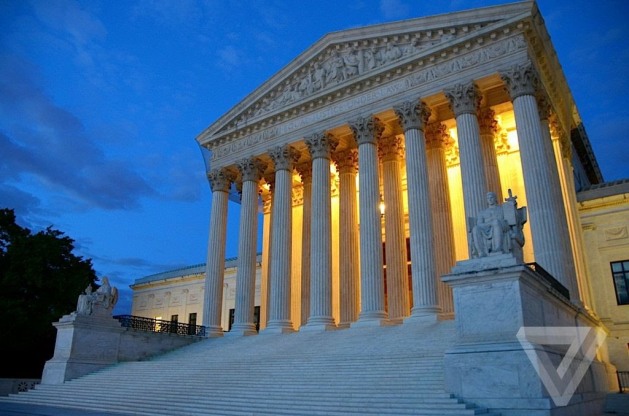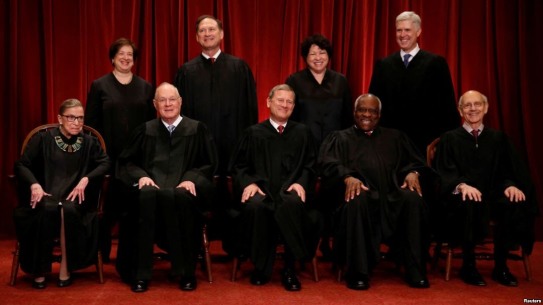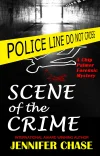
Photo courtesy of theverge.com.
The United States Supreme Court is the final authority on all cases that arise from American federal law or Constitutional issues. Over the past 50 years, the Justices of the Court have rendered a plethora of landmark criminal justice decisions. Here are four of those monumental judgments.
Escobedo v. Illinois (1964)
In January 1960, Danny Escobedo was arrested for the murder of his brother-in-law, Manuel Valtierra. Immediately upon his arrest, the police conducted an extensive interrogation of Escobedo, but they uncovered insufficient evidence to implicate him in the murder. So, Escobedo was released from police custody.
Shortly after his release, another suspect was arrested, and that perp provided credible testimony that Escobedo was the killer.
Escobedo was once again taken in by the police. He was told repeatedly to confess, but Escobedo refused to do so. Although Escobedo was not yet arrested, he was still in police custody – so he consistently requested to speak with an attorney. But, the police refused to allow Escobedo to speak with his lawyer. After 14 hours of interrogation, Escobedo provided enough statements to result in his arrest and subsequent murder conviction.
Escobedo appealed on the basis that he was refused his right to an attorney as guaranteed in the Sixth Amendment. In opposition, the government argued that he had not been formally charged and arrested, so his right to counsel had not yet attached.
The matter climbed the appeals ladder and made it all the way to the US Supreme Court. In its decision, the Court held that any person in police “custody,” has the right to speak to counsel. Meaning, a person does not have to be formally charged or arrested to be granted this right. Basically, the right attaches once the police hold the person against their will in any capacity.
This was a monumental holding by the Court, and it had a direct impact on how police conducted interrogations going forward.
Terry v. Ohio (1968)
In October of 1963, Cleveland Police detective Martin McFadden was on a routine patrol in downtown Cleveland. While on his beat, Detective McFadden noticed three men acting suspiciously in front of a jewelry store. Utilizing his 39 years of experience, McFadden had a strong feeling that these men were “casing” the joint for a potential robbery.
So, like any diligent police officer, McFadden confronted the men, identified himself as an officer of the law, and asked for their names. The men merely “mumbled” things under their breath and did not provide their names.
Detective McFadden then decided to frisk the men. And what he discovered was that one of the men was unarmed, but two of them were armed, including John W. Terry. Specifically, Terry had a pistol, whereas the other guy – Richard Clinton – had a revolver.
At his criminal trial, Terry moved to have the evidence of the gun suppressed claiming the police conducted an unlawful search and seizure. This matter rose through the appeals process and was eventually brought before the US Supreme Court.
In one of the nation’s most important criminal procedure judgments, the Court decided on two very crucial issues related to the Fourth Amendment (which focuses on unreasonable governmental searches and seizures).
First, the Justices held that police may stop a person if they have “reasonable suspicion” that such person has committed or is about to commit a crime. Second, the police are permitted to frisk (i.e. search) a suspect for weapons if they have “reasonable suspicion” that the person may be armed and dangerous.

Photo courtesy of voanews.com.
Enmund v. Florida (1982)
Early in the morning on a random day in April 1975, Earl Enmund sat in a getaway car, while his two cohorts robbed an elderly couple at their farmhouse. During the robbery, something went horribly wrong. The elderly couple wound up murdered. All three men were arrested for murder and eventually sentenced to death.
Throughout the criminal proceedings, Enmund maintained his innocence as to the murder. He argued that the state had no evidence that he participated in the murder, had any intent to kill, or had any knowledge that his accomplices were intending to kill. Because of his position, Enmund argued that sentencing him to death was in violation of the “cruel and unusual punishment” clause of the Eighth Amendment.
The US Supreme Court agreed with Enmund. The Court declared that a person convicted of a felony (during which a murder occurred) may not be sentenced to death if that person did not actually murder someone, attempt a murder, or intend that a murder take place.
Hamdi v. Rumsfeld (2004)
In 2001, while fighting in Afghanistan, the United States military detained Taliban soldier Yaser Hamdi. He was promptly moved to Guantanamo Bay. Labeled by the government as an “enemy combatant,” Hamdi only spent a relatively short period of time at Guantanamo before being sent to a military prison in Virginia.
Hamdi’s transfer was a result of the revelation that he was – in fact – an American citizen. At this juncture, Hamdi was being held indefinitely, with no trial date or access to an attorney. So, Hamdi’s father filed a legal petition on his behalf declaring that his son’s detention was unconstitutional. The argument was Hamdi’s indefinite detention violated the Due Process clause of the Fifth Amendment.
In rebuttal, the government argued that, in time of war, anyone who fights against the USA can be labeled an enemy combatant. And with that nefarious status comes restricted access to the American court system.
In a powerful judgment, the Supreme Court upheld the government’s right to designate certain people as enemy combatants, including US citizens. But, the ruling had a caveat – enemy combatants that are American citizens have the right to Due Process and to challenge their status in an impartial court of law.
This is just a small sample of the major criminal justice issues decided by the Supreme Court. Have any recent Supreme Court cases piqued your interest?
***
JUST RELEASED!
SCENE OF THE CRIME
A Chip Palmer Forensic Mystery

Please join me:



































All excellent cases. Miranda V. Arizona was a biggie also. My father was on the RI State Police at the time and I remember the very angry discussions among the troopers that this marked the end of the criminal justice system.
Good article as always
LikeLiked by 1 person
Thanks Joe 🙂 I talked with an old retired LAPD officer during that time in regard to Miranda V. Arizona and they said the same things, like, the criminals were going to have all the rights.
LikeLike